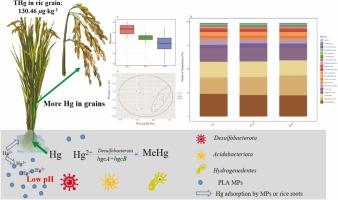Biodegradable polylactic acid microplastics enhance methylmercury production in soils and promote mercury accumulation in rice grains in Northeastern China
IF 11.3
1区 环境科学与生态学
Q1 ENGINEERING, ENVIRONMENTAL
引用次数: 0
Abstract
Microplastics (MPs), as emerging pollutants, have been accumulating in historically Hg-polluted paddy fields. However, the effects of MPs on mercury (Hg) methylation and subsequent accumulation in rice organs have remained poorly understood. We conducted controlled pot experiments to evaluate the impacts of replacing conventional polyvinyl chloride (PVC) with biodegradable polylactic acid (PLA) on Hg methylation processes in soil-rice systems. Results revealed that the addition of PLA-MPs significantly enhanced methylmercury (MeHg) formation in soil, leading to substantially higher Hg accumulation in rice grains. The average grain Hg concentration reached 130.46 μg∙kg-1 under PLA treatment - approximately 6-folds higher than in the controls. While MPs amendment reduced bacterial α-diversity (Shannon index), it did not substantially alter the overall microbial community composition. Notably, PLA-MPs significantly upregulated Hg methylation gene expression (hgcA and hgcB). Soil pH was significantly and negatively related to hgcA expression. Desulfobacterota was the predominant Hg-methylation taxon across all treatments. Importantly, hgcA and hgcB expression levels showed strong positive correlations with Hg accumulation in rice grains. Our findings emphasize the necessity for comprehensive risk assessment regarding the implementation of biodegradable MPs in Hg-rich agricultural soils, particularly concerning food safety implications stemming from enhanced Hg enrichment in rice grains.

可生物降解聚乳酸微塑料提高了东北地区土壤甲基汞的产生,并促进了稻米中汞的积累
微塑料(MPs)作为一种新兴的污染物,一直在长期受汞污染的稻田中积累。然而,MPs对汞甲基化和随后在水稻器官中积累的影响仍然知之甚少。通过盆栽对照试验,研究了生物可降解聚乳酸(PLA)替代常规聚氯乙烯(PVC)对土壤-水稻体系中汞甲基化过程的影响。结果表明,PLA-MPs的添加显著增强了土壤中甲基汞(MeHg)的形成,导致稻米中汞的累积量大幅增加。PLA处理的平均颗粒汞浓度达到130.46 μg∙kg-1,约为对照组的6倍。虽然MPs的修正降低了细菌α-多样性(Shannon指数),但并没有实质性地改变微生物群落的整体组成。值得注意的是,PLA-MPs显著上调汞甲基化基因表达(hgcA和hgcB)。土壤pH值与hgcA表达呈显著负相关。在所有处理中,脱硫菌群是主要的hg甲基化分类群。重要的是,hgcA和hgcB的表达水平与水稻中汞的积累呈强正相关。我们的研究结果强调了在富含汞的农业土壤中实施可生物降解MPs的综合风险评估的必要性,特别是关于稻米中汞富集增加对食品安全的影响。
本文章由计算机程序翻译,如有差异,请以英文原文为准。
求助全文
约1分钟内获得全文
求助全文
来源期刊

Journal of Hazardous Materials
工程技术-工程:环境
CiteScore
25.40
自引率
5.90%
发文量
3059
审稿时长
58 days
期刊介绍:
The Journal of Hazardous Materials serves as a global platform for promoting cutting-edge research in the field of Environmental Science and Engineering. Our publication features a wide range of articles, including full-length research papers, review articles, and perspectives, with the aim of enhancing our understanding of the dangers and risks associated with various materials concerning public health and the environment. It is important to note that the term "environmental contaminants" refers specifically to substances that pose hazardous effects through contamination, while excluding those that do not have such impacts on the environment or human health. Moreover, we emphasize the distinction between wastes and hazardous materials in order to provide further clarity on the scope of the journal. We have a keen interest in exploring specific compounds and microbial agents that have adverse effects on the environment.
 求助内容:
求助内容: 应助结果提醒方式:
应助结果提醒方式:


